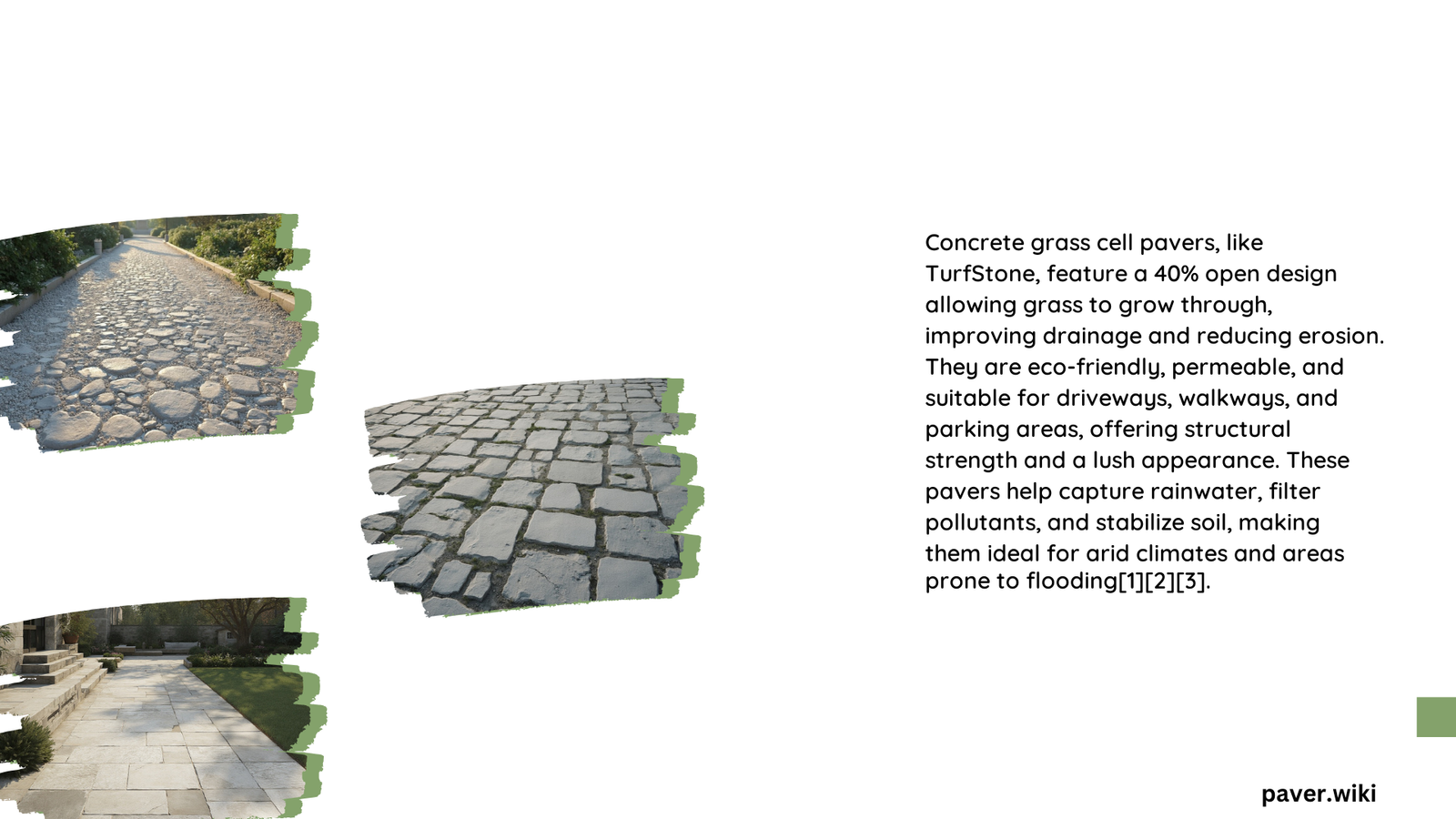Concrete grass cell pavers are innovative paving solutions that combine the strength of concrete with the environmental benefits of grass. These permeable pavers feature a grid-like structure with open cells that allow grass to grow through, creating a green surface while maintaining load-bearing capacity. Ideal for driveways, parking lots, and other high-traffic areas, concrete grass cell pavers offer a sustainable alternative to traditional paving methods, promoting natural drainage and reducing runoff.
What Are Concrete Grass Cell Pavers?
Concrete grass cell pavers are engineered paving systems designed to provide a stable, load-bearing surface while allowing grass to grow within their structure. These pavers typically consist of a grid or honeycomb pattern made from concrete, with open cells that can be filled with soil and grass seed. The result is a green, permeable surface that can withstand vehicular traffic while offering environmental benefits.
Key Features:
- High load-bearing capacity
- Permeable surface for natural drainage
- Supports grass growth
- Reduces heat island effect
- Environmentally friendly
How Do Concrete Grass Cell Pavers Work?

Concrete grass cell pavers function by distributing weight across their grid structure while providing space for grass to grow. The open cells allow water to percolate through, reducing runoff and promoting natural groundwater recharge. The concrete framework provides stability and durability, ensuring the surface can withstand heavy loads without compromising the grass growth within the cells.
What Are the Benefits of Using Concrete Grass Cell Pavers?
-
Improved Stormwater Management: The permeable nature of these pavers allows for natural water infiltration, reducing runoff and the strain on stormwater systems.
-
Enhanced Aesthetics: Combines the look of a lush green lawn with the functionality of a paved surface.
-
Reduced Heat Island Effect: Grass-filled cells help lower surface temperatures compared to traditional paving materials.
-
Increased Load-Bearing Capacity: Can support heavy vehicles while maintaining a green appearance.
-
Environmental Sustainability: Promotes natural drainage and supports local ecosystems.
What Are the Technical Specifications of Concrete Grass Cell Pavers?
| Specification | Typical Range |
|---|---|
| Compressive Strength | 4,000 – 8,000 psi |
| Cell Size | 2 – 4 inches |
| Thickness | 3 – 5 inches |
| Open Area | 30 – 50% |
| Load Capacity | Up to H-20 (highway loading) |
How to Install Concrete Grass Cell Pavers?
- Prepare the subgrade
- Install a geotextile fabric
- Add and compact the base layer
- Lay the concrete grass cell pavers
- Fill cells with soil and seed
- Water and maintain
What Are the Maintenance Requirements for Concrete Grass Cell Pavers?
- Regular mowing of grass
- Occasional reseeding of bare patches
- Periodic inspection for damage or settling
- Minimal snow removal requirements
How Do Concrete Grass Cell Pavers Compare to Traditional Paving Methods?
| Aspect | Concrete Grass Cell Pavers | Traditional Paving |
|---|---|---|
| Permeability | High | Low |
| Aesthetics | Natural, green appearance | Uniform, artificial |
| Environmental Impact | Low | Higher |
| Installation Complexity | Moderate | Simple |
| Initial Cost | Higher | Lower |
| Long-term Benefits | Significant | Limited |
What Are the Cost Considerations for Concrete Grass Cell Pavers?
The cost of concrete grass cell pavers can vary depending on several factors:
- Material costs: $5 – $15 per square foot
- Installation: $10 – $30 per square foot (including materials)
- Maintenance: Lower long-term costs compared to traditional paving
Factors affecting cost:
– Project size
– Site preparation requirements
– Local labor rates
– Customization needs
Where Can Concrete Grass Cell Pavers Be Used?
- Residential driveways
- Parking lots
- Emergency access roads
- Overflow parking areas
- Erosion control on slopes
- Golf cart paths
- Pedestrian walkways
What Are the Limitations of Concrete Grass Cell Pavers?
- Higher initial cost compared to traditional paving
- Requires proper installation for optimal performance
- May not be suitable for areas with very high traffic volume
- Grass may require more maintenance in high-use areas
How Do Concrete Grass Cell Pavers Contribute to LEED Certification?
Concrete grass cell pavers can contribute to LEED (Leadership in Energy and Environmental Design) certification in several ways:
- Sustainable Sites Credit: Reduces heat island effect
- Water Efficiency Credit: Promotes natural stormwater management
- Materials and Resources Credit: Can be made with recycled content
- Innovation in Design Credit: Innovative green building solution
What Are the Best Practices for Designing with Concrete Grass Cell Pavers?
- Conduct a thorough site analysis
- Consider traffic patterns and load requirements
- Plan for proper drainage and slope
- Choose appropriate grass species for local climate
- Integrate with existing landscaping and hardscaping
- Provide clear edges and transitions to other surfaces
How Do Concrete Grass Cell Pavers Perform in Different Climates?
- Hot Climates: Helps reduce heat island effect, may require drought-resistant grass species
- Cold Climates: Performs well with proper base preparation, allows for snow melt infiltration
- Wet Climates: Excellent for managing high rainfall, reduces pudding and runoff
- Dry Climates: Helps conserve water, may require supplemental irrigation for grass
What Are the Future Trends in Concrete Grass Cell Paver Technology?
- Enhanced material compositions for improved strength and durability
- Integration of smart technologies for water management
- Development of more eco-friendly production processes
- Increased use of recycled materials in paver production
- Improved designs for easier installation and maintenance
Concrete grass cell pavers represent a significant advancement in sustainable paving solutions. By combining the strength of concrete with the environmental benefits of natural grass, these pavers offer a versatile and eco-friendly option for various applications. As urban areas continue to grapple with stormwater management and the need for green spaces, concrete grass cell pavers provide an innovative solution that balances functionality with environmental stewardship.
References:
1. NDS EZ Roll Grass Pavers Technical Specification Guide
2. AgTec Heavy Duty Truck and Parking Pavers
3. Tufftrack Grass & Gravel Pavers Technical Specification Guide
